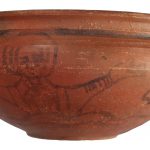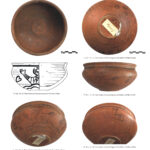| Artefact ID | 1029 |
| TM ID | - |
| Findspot (DEChriM ID) | 25 (Aḫmīm) | Class | Cooking/table/transport/storage ware |
| Material | Ceramic |
| Description | Deep bowl decorated with Christian iconography. Entirely preserved, the bowl shows signs of wear and tear only on the base ring, where the colour of the fine and dense clay is visible in isolated places, below the red coat of paint. This dark red coating covers completely both the inner and outer walls of the vessel as well as the base of the bowl. Onto this coating, were subsequently applied, perhaps with a brush, several symbols, which, considered all together, form an unambiguous Christian iconographic programme. One distinguishes thus a cross, a character displaying a female breast (on the opposite side of the cross), as well as what might be stylised fig tree leaves. In the central human figure, R. Forrer saw "Mary in tunic with wide stripe clavi, depicted as orans, in front of her child the Christ with a cross nimbus" (Forrer 1907: 465). In the spaces between the cross and this sedes sapientiae representation of the Madonna and the Child, are 12 leaves, divided in two groups of six, flanking the two key motifs mentioned above. Possibly stylised fig tree leaves, these 12 shapes might have a symbolic value, perhaps refering to the Apostles. The overall quality of the object and its decoration suggest that we are dealing here with a liturgical object, which might have been used for water, wine or hosts, as part of a eucharistic or baptismal rite. The fabric (marl or Aswān clay) indicates either a local production or an importation from Syēnē/Elephantinē. |
| Selection criteria | Christian symbols/gestures/isopsephy |
| Date from | 300 |
| Date to | 600 |
| Dating criteria | Ceramic typology and iconography. |
| Absolute/relative date | Relative date |
| Archaeological context | Uncertain. The bowl was either acquired by Forrer in Egypt in 1894 (?) or excavated in Aḫmīm. |
| Accession number | Berlin, Staatliche Museen, MBK-Inv.-Nr. 6638 |


 Json data
Json data





